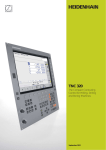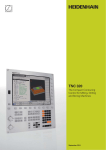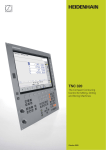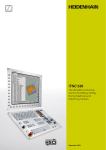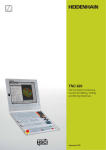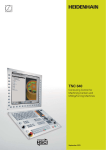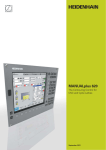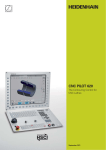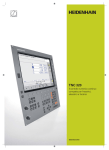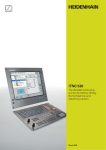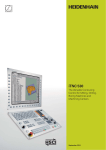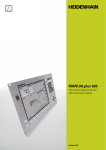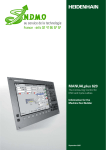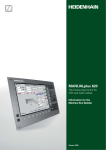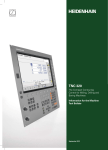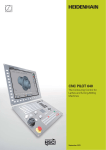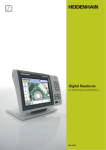Download TNC 640
Transcript
TNC 640
Contouring Control for
Machining Centers and
Milling/Turning Machines
September 2011
2
Contents
The TNC 640...
Where can it be used?
4
Versatile
– The TNC contouring control for milling and milling/turning machines
How does it look?
6
Well Designed and User Friendly
– The TNC 640 in dialog with the user
– The functional user interface
What can it do?
10
Multi-Operation Machining
– Milling and turning on one machine (option)
12
Quick and Reliable Machining with High Contour Fidelity
– Uniformly digital control design
14
Machining with Five Axes
– Swivel head and rotary table controlled by the TNC 640
– Optimal tool guidance
16
Minimize Setup Times
– The TNC 640 makes setup easy
18
Automated Machining
– The TNC 640 measures, manages and communicates
How is it programmed?
20
Programming, Editing, Testing
– The TNC 640 opens endless possibilities
– Graphic support in any situation
22
Programming in the Workshop
–
–
–
–
–
–
Straightforward function keys for complex contours
Programming contours unconventionally
Field-proven cycles for recurring operations
Field-proven turning cycles
Reusing programmed contour elements
Fast availability of all information
30
Open for Communication
– Fast data transfer with the TNC
– The TNC 640 programming station
Are there any accessories?
32
Workpiece Measurement
– Setup, presetting and measuring with touch trigger probes
33
Measurement of Milling Cutters
– Measuring length, radius and wear directly in the machine
34
Inspecting and Optimizing Machine Accuracy
– Calibrating rotary axes with KinematicsOpt
35
Positioning with the Handwheel
– Delicate axis traverse
... At a glance
36
Overview
–
–
–
–
User functions, accessories
Options
Specifications
Comparison of controls
3
Versatile
– The TNC Contouring Control for Milling and Milling/Turning
Machines
For more than 35 years, TNC controls from
HEIDENHAIN have been proving
themselves in daily use on milling, drilling
and boring machines, as well as machining
centers. While the controls have
undergone continuous development during
this period, the basic operational technique
has remained the same.
You will find also these principles
implemented in the TNC 640, the
HEIDENHAIN contouring control for milling
and milling/turning operations: shoporiented programmability with graphic
support, many field-proven cycles and an
operational design you'll recognize from
other HEIDENHAIN controls.
4
Shop-oriented programming
You program conventional milling and
drilling operations, and with the TNC 640
also turning operations, yourself at the
machine, in plain language dialog—the
workshop-oriented programming language
from HEIDENHAIN. The TNC 640 provides
you with optimum support with practical
prompts, questions and expressive
graphical aids—for turning operations, too.
Standard operations and even complex
applications are on call as a large variety of
real-world machining cycles or coordinate
transformations.
Simple operation
For simple work, such as face milling or
face turning, you need not write a program
on the TNC 640. It is just as easy to
operate the machine manually by pressing
the axis keys or—for maximum
sensitivity—using the electronic
handwheel.
Offline program creation
The TNC 640 can be programmed remotely
just as well. Your Fast Ethernet interface
guarantees very short transfer times, even
of long programs.
Universally applicable
The TNC 640 is particularly capable in
operations on milling/turning machines. The
TNC 640 is also intended for HSC and
5-axis operations on machines with up to
18 axes.
High speed milling
• Fast block processing
• Short control-loop cycle time
• Motion control low in jerk
• High spindle speed
• Fast data transfer
The TNC 640 is especially attractive for the
following areas of application:
Boring mill
• Cycles for drilling, boring and spindle
alignment
• Drilling oblique holes
• Control of quills (parallel axes)
Milling/turning machines
• Simple, program-controlled switchover
between milling and turning
• Comprehensive turning cycle package
• Constant surface speed
• Tool-tip radius compensation
Universal milling machine
• Shop-floor programming in HEIDENHAIN
conversational format
• Fast presetting with a HEIDENHAIN
touch probe
• Electronic handwheel
• Machining centers and automated
machining
• Tool management
• Pallet management
• Controlled presetting
• Reference-point management with
preset tables
• Automatic workpiece measurement with
HEIDENHAIN touch probes
• Automatic tool measurement and
breakage inspection
• Connection with host computer
• Five-axis machining with swivel head
and rotary table
• Tilting the working plane
• Cylindrical surface machining
• Tool Center Point Management (TCPM)
• 3-D tool compensation
• Fast execution through short block
processing times
5
Well Designed and User Friendly
– The TNC 640 in Dialog with the User
The screen
The large TFT 19-inch color monitor shows
a clear overview of all relevant information
for programming, operating and inspecting
the machine tool and control, such as
program blocks, comments and error
messages. More information is provided
through graphic support during program
entry, test run and actual machining.
The selectable “split screen” display
shows the part program blocks in one half
of the screen and the graphics or
the status display in the other half.
During the course of the program, status
displays will always offer information on
tool position, the current program, active
cycles and coordinate transformations, and
other data. The TNC 640 even shows the
current machining time.
The keyboard
As with all TNCs from HEIDENHAIN, the
keyboard is tailored to the programming
process. The well-thought-out arrangement
of keys in a clear division into functions
groups programming modes, machining
modes, management/TNC functions and
navigation support you during program
input. Simple key assignment, easily
understandable symbols or abbreviations
clearly indicate each key’s function.
The alphabetic keypad enables you to
easily enter comments and G codes. The
integrated machine operating panel
features easily exchangeable snap-on keys
that allow simple adaptation to the
respective machine configuration. You use
the override potentiometers to make
delicate adjustments of feed-rate, rapid
traverse and spindle speed. And the
operating panel features a complete set of
PC keys and a touchpad that can be used,
for example, for operating the DXF
converter.
6
Ergonomic and elegant, state-of-the-art
and field-proven—HEIDENHAIN controls
in a new design. Judge for yourself:
The screen content includes two
operating modes, the program, graphics
and the machine status
PLC function keys (soft keys) for machine
functions
Keys for screen management (screen
layout), mode of operation and for shifting
between soft-key rows
Self-explanatory function keys (soft keys)
for NC programming
Alphanumeric keyboard for comments or
DIN/ISO programs and a set of PC keys for
controlling the operating system functions.
Durable
The high-quality stainless steel design of
the TNC 640 features a special protection
coating and is therefore highly resistant to
soiling and wear.
Smooth
The rectangular, slightly rounded keys are
pleasant for your fingers and reliable in
operation. Their inscriptions stay free of
wear even under extreme workshop
conditions
Flexible
The integrated machine operating panel
features easily exchangeable snap-on keys.
Reliable
The elevated key bed of the machine
operating panel prevents accidental
actuation. LEDs serve for status display of
each key by clearly indicating the active
machine functions.
USB port for additional data storage or
pointing devices
Versatile
Soft keys both for the programming and
the machine functions always show only
the currently available selection.
Axis-selection keys and numeric keypad
Sensitive
With the handy control knobs you can
individually adjust the feed-rate, rapid
traverse and spindle speed.
Override potentiometers for feed rate,
rapid traverse and spindle speed
Function keys for programming modes,
machine modes, TNC functions,
management and navigation
Communicative
The fast USB 2.0 interface lets you connect
storage media or pointing devices to the
keyboard simply and directly.
Machine operating panel with snap-on
keys and LEDs
7
Well Designed and User Friendly
– The Functional User Interface
The combination of the straightforward and
ergonomically correct keyboard and the
well-designed screen layout are the
essence of reliable and fatigue-free
operation. These are principles that
HEIDENHAIN controls have always
embodied. However, the TNC 640 also
offers a number of features that make
working with the control even easier and
user-friendlier than ever.
Attractive view
The user interface of the TNC 640 has a
modern appearance, with lightly rounded
forms, color gradients and a
homogeneously designed font. The
individual screen areas are clearly distinct,
the two main operating modes Machining
and Programming and Editing are indicated
by dialog texts and the respective
operating mode signals.
To better distinguish between the priority
of error messages, the TNC 640 displays
them in color-coded categories. A colorcoded warning triangle is also displayed.
Fast function overview
With smartSelect you enjoy dialog
guidance for selecting functions quickly
8
and easily that up to now were accessible
only through the soft-key structure. As
soon as you open smartSelect, it displays a
tree structure with all subordinate functions
that can be defined in the control’s current
condition. Moreover, in the right part of the
smartSelect window, the TNC displays the
integrated help. With the cursor or a
mouse click, you immediately access
detailed information on the respective
function. smartSelect enables you to
define fixed cycles, touch probe cycles,
special functions (SPEC FCT), and quickly
access the parameter programming.
Color-structured programs
The content of a program line can be quite
comprehensive: line number, program
function, input values, comment. To help
you always find your way even in complex
programs, the individual program elements
on the TNC 640 are shown in different
colors. The color syntax highlighting
improves your overview when editing NC
programs. It enables you to see at a
glance, for example, where the editable
input values are.
Uniform table editor
Regardless of which table you are editing—
whether the tool table, preset table or
pallet table—the function and operation of
the table editor are always the same.
Info line
In the info line, the TNC 640 shows the
respective submode condition and helps
you to orient yourself. The function is
comparable with the history function in
web browsers.
MOD function
The additional mode MOD was thoroughly
overhauled and now offers a myriad of
possible settings in a standardized layout
regardless of the operating mode.
9
Multi-Operation Machining
– Milling and Turning on One Machine (Option)
Does your workpiece, after complex milling
operations, also need to be set up on a
lathe for several working steps? Do you
have to plan for machine capacity, make
tools, set up and fix the workpiece, and
measure the finished part? The TNC 640
helps you to save time: on a milling/turning
machine with TNC 640 you machine the
complete workpiece on one machine:
milling, turning, milling, in whatever
sequence. After performing all operations
on one machine, you measure the finished
workpiece with a HEIDENHAIN touch
probe.
The TNC 640 offers you powerful functions
that enable you to switch the NC program
as desired between turning and milling
under program control. This enables you to
decide with complete freedom how and
when you want to combine the two
machining methods. And of course, the
operations switch back and forth regardless
of the machine and its axis configuration.
During switchover, the TNC 640 assumes
all necessary internal changes, such as
switching to diameter display, setting the
datum in the center of the rotary table, and
even machine-dependent functions such as
clamping the tool spindle.*
Programming as accustomed
You can program the turning operations—
as always—conveniently under dialog
guidance in HEIDENHAIN plain-language.
Besides the standard path functions you
can also use FK free contour programming
to easily create contour elements not
otherwise dimensioned for NC. Beyond
this, you also have the contour elements
recessing and undercutting for turning
operations, which are supported by
expressive help illustrations.
* The machine must be prepared by the machine tool
builder for this function.
10
Cycles for milling and turning
HEIDENHAIN controls have always been
known for their comprehensive and
technologically sophisticated package of
cycles. Frequently recurring operations that
comprise several steps are also stored in
the TNC 640 as cycles. You program them
under conversational guidance and are
supported by valuable help graphics that
clearly illustrate the required input
parameters. Besides the well known TNC
milling and drilling cycles, the TNC 640 also
offers a wide variety of turning cycles, for
example for roughing, finishing, recessing
and thread turning. The field-proven
HEIDENHAIN lathe controls provided the
software basis for the turning functions.
They enable you to very easily program
even complex turning operations at the
machine.
In the more sophisticated contour turning
cycles, the TNC 640 uses the same
techniques as are used for milling. Here,
too, there is no need for the TNC
programmer to learn new ways of
programming—he can continue to rely on
what he already knows and quickly find his
way into the world of turning on a milling
machine.
11
Quick and Reliable Machining with High Contour Fidelity
– Uniformly Digital Control Design
Thanks to its digital design, the TNC 640
has control over the machine’s entire drive
system. Not only does the field-proven
digital drive technology from HEIDENHAIN
make high contour fidelity and rapid
machining at high speeds possible, but
also all control components of the TNC 640
are connected via digital interfaces.
12
Digital drive technology
The position controller, speed controller
and, if required, the current controller are
integrated in the TNC 640. The digital motor
control makes it possible to attain very high
feed rates. While interpolating simultaneously in up to five axes, the TNC 640
reaches the required cutting speeds by
digitally controlling spindle speeds up to
60 000 rpm.
High contour fidelity
The TNC 640 dynamically calculates the
contour in advance. This enables it to adapt
the axis velocities early enough to the
contour transitions. It controls the axes
with special algorithms that ensure path
control with the required limits to velocity
and acceleration.
Highest contour fidelity and surface
quality
Special filters specifically suppress
machine-specific natural vibration. The
desired accuracy is attained with the very
high surface quality. Thanks to the short
block processing time of 0.5 ms, even
highly accurate contours with very high
resolution are not a problem.
Fast machining at specified accuracy
You as user specify the accuracy of the
machine contour—apart from the NC
program. You simply enter in the control
through a cycle the maximum permissible
deviations from the ideal contour. The TNC
640 automatically adapts the machining to
the tolerance that you define. No contour
damage occurs with this method.
High availability
In the uniformly digital control concept of
the TNC 640, all components are
connected to each other via purely digital
interfaces: The control components are
connected via HSCI (HEIDENHAIN Serial
Controller Interface), the real-time protocol
from HEIDENHAIN for Fast Ethernet, and
the encoders are connected via EnDat2.2,
the bidirectional interface from
HEIDENHAIN.
This achieves a high degree of availability
for the entire system. It can be diagnosed
and is immune to noise—from the main
computer to the encoder.
The uniformly digital design from
HEIDENHAIN guarantees not just very
high accuracy and surface quality, but high
machining speeds as well—regardless of
whether you are milling or turning.
Rotary encoder
Controller
unit
CC
Main
computer
MC
Inverter
PWM
Motor
Linear encoder
HSCI
HSCI
EnDat 2.2
EnDat 2.2
Machine
operating
panel
EnDat 2.2
HSCI
PL
HSCI
Handwheel
PL
Angle encoder
13
Machining with Five Axes
– Swivel Head and Rotary Table Controlled by the TNC
Many five-axis operations that at first
glance may seem very complex can be
reduced to conventional 2-D movements
that are simply tilted about one or more
rotary axes or wrapped onto a cylindrical
surface. The TNC supports you with
application-oriented functions to help you
write and edit such programs quickly and
simply without a CAD/CAM system.
14
Tilting the working plane* (option 8)
Programs for contours and holes on
inclined surfaces are often very complex
and require time-consuming computing
and programming work. Here the TNC 640
helps you to save a great deal of
programming time.
You program the part as usual in the
working plane (e.g. the X/Y plane), but it is
machined in a plane that is rotated in one
or more axes about the main plane.
The PLANE feature makes it easy to define
a tilted working plane: You can specify tilted
working planes in seven different ways,
depending on the information on the
workpiece drawing. Clearly arranged
support graphics assist you during input.
You can define the positioning behavior
with the PLANE function so that there are
no unpleasant surprises when the program
is run. The settings for defining the
positioning behavior are identical for all
PLANE functions, making everything that
much easier.
– Optimal Tool Guidance
Five-axis machining (option 9)
When machining with five axes (three
linear axes and two tilting axes)*, the tool
can stay perpendicular, or if desired,
inclined at a predetermined angle to the
workpiece surface. To generate an NC
program, the CAD system only needs to
calculate the points on the workpiece
surface and the angles of the tilting axes.
The TNC 640 automatically compensates
the machine’s geometry* and the tool
length, and it compensates the tool radius
in 3-D. Also, it calculates the feed rate so
that it remains constant at the tool tip.
Feed rate for rotary tables in mm/min*
(option 8)
In the standard version, the feed rate of
rotary axes is programmed in degrees/
minute. However, the TNC 640 can
interpret this feed rate in mm/min as well.
The feed rate at the contour is then
independent of the distance of the tool
center from the center of the rotary axis.
Cylindrical surface machining*
(option 8)
With the TNC 640 it is quite easy to
program contours (which consist of straight
lines and arcs) on cylindrical surfaces using
rotary and tilting tables: You simply
program the contour in a plane as if the
cylinder surface were unrolled. The
TNC 640 then executes the operation on
the surface of the cylinder.
The TNC 640 features three cycles for
cylindrical surface machining:
• Slot milling (the slot width is the same as
the tool diameter)
• Guide-groove milling (the slot width is
greater than the tool diameter)
• Ridge milling
* The machine must be prepared by the machine tool
builder for this function.
15
Minimize Setup Times
– The TNC 640 Makes Setup Easy
Before you can begin machining, you must
first clamp the tool and set up the machine,
find the position and orientation of the
workpiece on the machine, and set the
workpiece reference point. This is a timeconsuming but indispensable procedure.
After all, any error directly reduces the
machining accuracy. Particularly in small
and medium-sized production runs, as well
as for very large workpieces, setup times
become quite a significant factor.
The TNC 640 features application-oriented,
real-world setup functions. They support
the user, help to reduce non-productive
time, and make overnight, unattended
production possible. Together with the
touch probes, the TNC 640 offers
numerous probing cycles for automatic
alignment of the workpieces, presetting,
and measurement of the workpiece and
the tool.
16
Delicate manual traverse
For setup, you can use the direction keys
to move the machine axes manually or in
incremental jog. A simpler and more
reliable way, however, is to use the
electronic handwheels from HEIDENHAIN
(see page 35). Particularly with the portable
handwheels you are always close to the
action, enjoy a close-up view of the setup
process, and can control the infeed
responsively and precisely.
Workpiece alignment
With HEIDENHAIN touch probes (see page
32) and the probing functions of the TNC
640, you can forgo any tedious manual
alignment of the workpiece:
• Clamp the workpiece in any position.
• The touch probe ascertains the
workpiece misalignment by probing a
surface.
• The TNC 640 compensates the
misalignment with a “basic rotation,”
which means that in the NC program the
part is rotated by the measured
misalignment.
Compensating workpiece misalignment
Compensate misalignment by rotating the
coordinate system or turning the table
Workpiece presetting
You can use a reference point to assign a
defined value in the TNC display to any
workpiece position. Finding this point
quickly and reliably reduces nonproductive
time and increases machining accuracy.
The TNC 640 features probing cycles for
automatic presetting. Once found, you can
save reference points:
• in the workpiece preset table,
• in a workpiece datum table, or
• by directly setting the displayed value.
Preset table: The TNC’s central reference
point management
The preset table makes flexible machining,
shorter setup times and increased
productivity possible. In other words, it
makes it much easier to set up the
machine.
In the preset table you can save any
number of reference points and assign an
individual basic rotation to each one.
There are three ways to save reference
points in the preset table:
• In the Manual mode by soft key
• By using the probing functions
• With the automatic probing cycles
Workpiece presetting
At a corner, for example, or in the center of
a circular stud
17
Automated Machining
– The TNC 640 Measures, Manages and Communicates
The difference in requirements placed on
the classical machine for tool and moldmaking and machining centers are
becoming ever less distinct. Of course, the
TNC 640 is capable of controlling
automated manufacturing processes. It
masters the range of functions needed to
start the proper machining operations on
individual workpieces in any setup and
even in interlinked machining.
18
Inspecting workpieces for proper
machining and dimensional accuracy
The TNC 640 features a number of
measuring cycles for checking the
geometry of the machined workpieces. To
run the measuring cycles, you insert a
touch probe from HEIDENHAIN (see
page 32) into the spindle in place of a tool.
This enables you to
• recognize a workpiece and call the
appropriate part program,
• check whether all machining operations
were conducted correctly,
• determine infeeds for finishing,
• detect and compensate tool wear,
• check the workpiece geometry and sort
the parts,
• log measured data, and
• ascertain the machining error trend.
Milling cutter measurement and
automatic compensation of tool data
Together with the TT 140 touch probe for
tool measurement (see page 33) the TNC
640 can automatically measure milling
cutters while they are in the machine. The
TNC 640 saves the ascertained values of
tool length and radius in the central tool
file. By inspecting the tool during
machining you can quickly and directly
measure wear or breakage to prevent
scrap or rework. If the measured deviations
lie outside the tolerances, or if the
monitored life of the tool is exceeded, the
TNC 640 locks the tool and automatically
inserts a replacement tool.
Tool management
For machining centers with automatic tool
changers, the TNC 640 offers a central tool
memory for any number of milling and
turning tools. The tool memory is a freely
configurable file and can therefore be
optimally fitted to your needs. You can even
have the TNC 640 manage your tool
names. The control prepares the next tool
change while the current tool is still cutting.
This significantly reduces the non-cutting
time required for changing tools.
Pallet management
The TNC 640 can assign the appropriate
part program and datum shift to parts
mounted on pallets and brought to the
machine in any sequence. If a pallet is
exchanged, the TNC 640 automatically calls
the correct part program. This permits
automatic machining of a variety of parts in
any sequence.
With the optionally available expanded tool
management you can also graphically
prepare and display any data*
* The machine must be prepared by the machine tool
builder for this function.
19
Programming, Editing, Testing
– The TNC 640 Opens Endless Possibilities
The TNC 640 is just as universal in
application as it is flexible in machining and
programming.
Positioning with manual data input
You can start working with the TNC 640
even before writing a complete part
program. Simply machine a part step by
step—switching as you want between
manual operation and automatic
positioning.
Programming at the machine
HEIDENHAIN controls are workshop
oriented, which means that they were
conceived for programming right at the
machine. With conversational programming
you can forget about memorizing G codes.
Instead you use dedicated keys and soft
keys to program line segments, circular
arcs and cycles. With a keystroke, you
initiate a HEIDENHAIN plain language
dialog, and the TNC begins immediately to
support you actively in your work.
Unambiguous questions and prompts help
you enter all the required information.
Whether plain-language prompts, dialog
guidance, programming steps or soft keys,
all texts are available in numerous
languages.
20
Creating programs offline
The TNC 640 is also well equipped for
offline programming. It can be integrated
through its interfaces into networks and
connected with programming stations or
other data storage devices. The TNC 640
can also run programs that were written in
DIN/ISO format.
– Graphic Support in Any Situation
Interactive programming graphics
The two-dimensional programming
graphics give you additional security: while
you are programming, the TNC 640 draws
every entered traverse command on the
screen.
Test run graphics
To play it safe before running a program,
the TNC 640 can graphically simulate the
milling of the workpiece. The TNC 640 can
display the simulation in the following
ways:
• In a plan view with different shades of
depth
• In three planes (as in the workpiece
drawing)
• In a solid model, 3-D view
Details can be displayed in magnification.
In addition, the TNC 640 indicates the
calculated machining time in hours,
minutes and seconds.
Program-run graphics
On the TNC 640, you can run the programrun graphics or verification graphics even
while the workpiece is being machined.
Also, it shows a real-time graphic of the
milling progress during program run.
Coolant spray and protective enclosures
usually obstruct any direct view of the
actual workpiece. You can get around this
with a simple keystroke to see the
simulated progress of workpiece milling.
Help graphics
During cycle programming in the plainlanguage dialog, the TNC shows a separate
illustration for each parameter. This makes
it easier to understand the function and
accelerates programming. The TNC 640
also supports you with useful help graphics
when programming the PLANE function
and the contour elements for turning.
21
Programming in the Workshop
– Straightforward Function Keys for Complex Contours
Programming 2-D Contours
Two-dimensional contours are the daily
bread of the modern machine shop. The
TNC 640 offers a variety of possibilities
here. And—regardless of whether you are
programming a milling or turning contour—
you always use the same tools. For you
this means that you do not have to relearn,
just continue to program as usual.
Programming with path function keys
If contours are dimensioned for NC, which
means that the end points are specified in
Cartesian or polar coordinates, then you
can program them directly with the path
function keys.
Straight and circular contour elements
To program a line segment, for example,
simply press the key for linear traverse. The
TNC 640 asks for all information required
for a complete programming block, such as
target coordinates, feed rate, tool
compensation and machine functions.
Appropriate path function keys for circular
movement, chamfers, and corner rounding
simplify your programming. To avoid
surface blemishes during approach or
departure from the contour, it must be
approached smoothly—that is, tangentially.
You simply specify the starting or end point
of the contour and the approaching or
departing radius of the cutter edge—the
control does the rest for you.
The TNC 640 can look ahead over a radiuscompensated contour for up to 99 blocks
to watch for back cutting and avoid contour
damage such as can occur when roughing
a contour with a large tool.
CT
Straight line defined
by its end point
Rounding: circular path defined by radius and
corner point, with a
smooth (tangential)
transition to its adjoining contour elements
RND
Circular path defined
by its end point, with
a smooth (tangential)
departure from the
previous contour
element
CC
C
Circular path defined
by its center, end
point, and rotational
direction
Chamfer
defined by the
corner point and
chamfer length
CHF
CR
Circular path defined
by its radius, end point
and rotational
direction
22
– Programming Contours Unconventionally
FK free contour programming
Not all workpieces are dimensioned for
conventional NC programming. Thanks to
FK, the control’s free contour programming
feature, in such cases you simply type in
the known data—without first having to
convert or calculate your data! It does not
matter if individual contour elements are
not completely defined as long as the
complete contour has been. If the given
data result in more than one mathematical
solution, the helpful TNC 640 programming
graphics present the possible variants for
your selection.
Lathe-specific contour elements
(option)
The TNC 640 provides special contour
elements to enable you to define recesses
and undercuts. Axial or radial recesses can
be defined over the GRV (groove) function.
With the aid of dialog guidance and help
graphics, you use the proper parameters to
define the desired recess.
Undercuts can be defined using the UDC
function. Here the forms E, F, H, K and U
are available as well as thread undercuts.
23
Programming in the Workshop
– Field-Proven Cycles for Recurring Operations
Comprehensive Fixed Cycles for
Milling, Drilling and Boring
Frequently recurring operations that
comprise several working steps are stored
in the TNC 640 as cycles. You program
them under conversational guidance and
are supported by graphics that clearly
illustrate the required input parameters.
Standard cycles
Besides the fixed cycles for drilling and
tapping (with or without floating tap
holder), there are optional cycles for thread
milling, reaming, boring and for hole
patterns, as well as milling cycles for
clearing plane surfaces, and for roughing
and finishing pockets, slots and studs.
24
Cycles for complex contours
Clearing pockets with combined contours
is aided greatly by Subcontour List cycles
(SL). This term is used to identify machining
cycles for pilot drilling, roughing and
finishing when the contour or subcontours
are specified in subroutines. In this way,
one contour description can be used for
more than one operation using different
tools.
Up to twelve subcontours can be
superimposed for machining. The control
automatically calculates the resulting
contour and the tool paths for roughing or
clearing the surfaces. Subcontours can be
pockets or islands. Different components
are combined to form a single pocket in
which the tool avoids the islands.
The TNC 640 maintains a finishing
allowance on the wall and floor surfaces
during roughing. When roughing with
different tools, the control identifies
material remaining in inside corners so that
it can be cleared later with smaller tools. A
separate cycle is used for milling to the
finished dimension.
Stay simple and flexible when
programming machining patterns
Machining positions are often arranged in
patterns on the workpiece. With the
TNC 640, you can program very diverse
machining patterns simply and extremely
flexibly—of course with graphic support.
You can define as many point patterns as
desired with various numbers of points.
3-D machining with parametric
programming
With parameter functions you can program
simple 3-D geometric figures that can
easily be described mathematically. Here
you can use the basic arithmetical
operations, trigonometric functions, roots,
powers, logarithmic functions, parentheses, and logical comparisons with
conditional jump instructions. Parametric
programming also offers you a simple
method of realizing 3-D operations for
which there are no standard cycles. Of
course, parametric programming is also
suited for 2-D contours that cannot be
described with line segments or circular
arcs, but rather through mathematical
functions.
OEM cycles
As original equipment manufacturers
(OEMs), machine tool builders can
contribute their special manufacturing
know-how by designing additional fixed
cycles and saving them in the TNC 640.
However, the end user can write his own
cycles as well. HEIDENHAIN makes this
possible with its PC program CycleDesign.
CycleDesign enables you to organize the
input parameters and soft-key structure of
the TNC 640 to suit your own needs.
25
Programming in the Workshop
– Field-Proven Turning Cycles (Option)
In the area of milling cycles, too, the
TNC 640 offers a comprehensive and
technologically ambitious package. The are
equivalent to the proven and fully
developed kernel functions of the
HEIDENHAIN lathe controls. The user
interface, however, is inspired in its look
and functionality by the familiar and proven
plain-language dialog. Cycle parameters
that come into use both for milling and
turning are, of course, used with the same
number. For turning operations, as well,
you are supported during programming as
accustomed with explanatory graphics.
26
Machining simple contours
Various cycles are available for machine
simple contours in longitudinal and
transverse direction. The surface to be
machined might also be inclined and can
require a plunging movement. Naturally,
the TNC 640 fully automatically takes the
angle of the turning tool into account.
Machining any desired contours
If the contours to be machines become
more complex and can no longer be
defined with simple cycle parameters, you
can describe them using contour
subprograms. The process is completely
identical to the procedure when using SL
cycles in milling: with Cycle 14 you define
the subprogram in which the finished
contour is described, and in the respective
turning cycle you specify the technological
parameters.
During contour description, too, you use
exactly the same conversational functions
as when defining a milling contour, which
of course includes FK free contour
programming. Moreover, the turningspecific contours elements recess and
undercut are available, which you can insert
between contour elements like chamfers
and rounding arcs. Besides radial and axis
recesses, undercuts are available of the
forms E, F, H, K, U and thread undercuts.
Depending on the cycle, the TNC 640
machines parallel to the axis or the contour.
You define the machining operations
(roughing, finishing) or oversize under
dialog guidance through the corresponding
parameters.
Recessing
In this area, as well, the TNC 640
distinguishes itself with ample flexibility
and functionality. Simple recessing
operations in longitudinal and transverse
direction are just as possible as contour
recessing, in which the cycle is machined
along any desired contour. Here, too, the
TNC considers the technological
constraints (width of recessing tool from
the tool table) and executes the operations
quickly and reliably.
Thread machining
Simple and expanded cycles are available
for longitudinal and transverse machining of
cylindrical or tapered threads. You can use
cycle parameters to define the manner in
which the thread is produced. This enables
you to machine a wide variety of materials.
Orientation of the turning tool
Milling/turning machines sometime require
that the tool be held at an angle during
turning or that the side from which the
machining begins be changed The TNC
provides a simple cycle for such cases. This
makes it possible to use an outside turning
tool as an inside tool without having to
adjust the tool tip and/or the angle of
orientation on the tool table.
27
Programming in the Workshop
– Reusing Programmed Contour Elements
Coordinate transformation
If you should need a contour that has
already been programmed at another
position or in a different size, the TNC 640
offers you a simple solution: coordinate
transformation.
Depending on the machining task, you can,
for example rotate (milling), mirror (milling)
or shift the datum (milling and turning) in
the coordinate system. With a scaling
factor (milling) you can enlarge or reduce
contours to respect shrinkage allowance or
oversizes.
28
Program section repeats, subprograms,
program calls
Many machining operations repeat
themselves either on the same workpiece
or on different workpieces. Once you have
programmed a detail there is no reason to
have to program it again. With its
subprogramming feature, the TNC can save
you a great deal of programming time.
In program section repetition, you label a
section of the program and during program
run the TNC repeats the section
successively as many times as required.
You can mark a program section as a
subprogram and then call it at any point in
the program and as often as you want.
With the program call function you can
even use a completely separate program at
any place in your current program. This
gives you convenient access to preprogrammed, frequently needed working
steps or contours.
Of course you can also combine these
programming techniques as often as
desired.
– Fast Availability of All Information
Do you have questions on a programming
step, but your User’s Manual is not at
hand? No problem: Both the TNC 640 and
the TNC 640 programming station feature
TNCguide, a convenient help system that
can display the user documentation in a
separate window.
You can activate TNCguide by simply
pressing the help key on the TNC keyboard
or by clicking any soft key with a cursor in
the shape of a question mark. You switch
the cursor by simply clicking the help
symbol (
) that is always visible on all
TNCguide usually displays the information
in the immediate context of the element in
question (context-sensitive help). This
means that you immediately receive the
relevant information. This function is
particularly helpful with the soft keys. The
method and effect of operation is explained
in detail.
The following manuals are available in the
help system:
• User’s Manual for Conversational
Programming
• User’s Manual for Cycle Programming
• DIN/ISO Programming User's Manual
• User’s Manual for the TNC 640
Programming Station (only included in
the programming station)
You can download the documentation in
the desired language from the
HEIDENHAIN homepage into the
corresponding language directory on the
TNC hard disk.
TNC screens.
TNCguide integrated in the control, e.g. on the TNC 640 ...
… or at the programming station
29
Open for Communication
– Fast Data Transfer with the TNC
The networked TNC 640
The TNC 640 can be integrated into
networks and connected with PCs,
programming stations and other data
storage devices. Even in its standard
version, TNC 640 features a latestgeneration Fast Ethernet interface in
addition to its RS-232-C/V.24 data interface.
The TNC 640 communicates with NFS
servers and Windows networks in TCP/IP
protocol without needing additional
software. The fast data transfer at rates of
up to 100 Mbps guarantees very short
transfer times.
Company Network
Programming
system
TNC 320
Ethernet
interface
TNC 640
Ethernet
interface
iTNC 530
Ethernet
interface
30
The transmitted programs are saved in the
internal memory of the TNC 640 and are
run from it at high speed.
For well-organized program management
on your control, simply place the individual
files in directories (folders). You can
structure the respective directories through
individual subdirectories.
Programs for data transfer
With the aid of the free PC program
TNCremo from HEIDENHAIN and an
Ethernet or other data interface you can
• transfer remotely stored part programs
and tool or pallet tables in both directions
and
• start the machine.
With the powerful TNCremoPlus software
you can also transfer the screen contents
of the control to your PC by means of the
live-screen function.
– The TNC 640 Programming Station
Why a programming station?
It’s well known that it is easy to create part
programs on a TNC 640 at the machine,
even while another part is being machined.
Nevertheless, it can often happen that
short reloading times and other machining
tasks hinder any prolonged or concentrated
programming work. With the TNC 640
programming station you have the
capability to program just as you do at the
machine, but away from the noise and
distractions of the shop floor.
Creating programs
Programming, testing and optimizing
HEIDENHAIN conversational or DIN/ISO
programs with the programming station
substantially reduces machine idle times.
You need not adjust your way of thinking—
every keystroke fits. On the programming
station you program on the same keyboard
as at the machine.
Testing of programs created offline
Of course you can also test programs that
were written on a CAD/CAM system. The
various views of the program verification
graphics help you to easily spot contour
damage and hidden details.
Training with the programming station
Because the TNC 640 programming station
is based on the same software as the TNC
640, it is ideally suited for apprentice and
advanced training. The program is entered
on the original keyboard unit. Even the test
run functions exactly as it does on the
machine. This gives the trainee the
experience needed to enable him to safely
operate the machine later.
Because it can be programmed with
smarT.NC, in plain language, and in ISO,
the TNC 640 programming station can also
be used in schools for TNC programming
training.
Your workstation
The programming station software runs on
a PC. The PC screen shows you the TNC
user interface as on the control, and offers
the familiar graphic support. Depending on
the version of the programming station,
there are several types of possibilities for
using it.
The free demo version contains all
functions of the TNC 640, and permits
short programs to be saved. It is
programmed over the PC keyboard.
On the version with the TNC operating
panel you then create your programs as
always, on a keyboard with the same
function keys as the control on the
machine. It also has a PC keyboard for
G-code programming, file names and
comments.
But you can also work without the TNC
operating panel: a virtual keyboard
simulating the TE appears on the PC
screen. It provides the TNC 640’s most
important dialog initiation keys.
31
Workpiece Measurement
– Setup, Presetting and Measuring with Touch Trigger Probes
Workpiece touch probes from
HEIDENHAIN help you to reduce costs in
the workshop and in series production:
Together with the TNC 640, touch probes
can automatically perform setup,
measuring and inspection functions.
The stylus of a TS touch trigger probe is
deflected upon contact with a workpiece
surface. At that moment the TS generates
a trigger signal that, depending on the
model, is transmitted either by cable or
over an infrared beam to the control.
The touch probe* is inserted directly into
the machine tool spindle. It can be
equipped with various shanks depending
on the machine. The ruby ball tips are
available in several diameters, and the styli
in different lengths.
Touch probe with cable connection for
signal transmission for machines with
manual tool change:
TS 220 – TTL version
Touch probes with infrared signal
transmission for machines with automatic
tool change:
TS 440 – Compact dimensions
TS 444 – Compact dimensions, batteryfree power supply through integrated air
turbine generator over central compressed
air supply
TS 640 – Standard touch probe with widerange infrared transmission
TS 740 – High probing accuracy and
repeatability, low probing force
* The touch probes must be interfaced to the TNC 640
by the machine tool builder.
SE 640
TS 220
TS 640
TS 440
More information about workpiece touch
probes is available on the Internet at
www.heidenhain.com or in the brochure
or CD Touch Probes.
32
Measurement of Milling Cutters
– Measuring Length, Radius and Wear Directly in the Machine
The tool is of course a definitive factor in
ensuring a consistently high level of
production quality. This means that an
exact measurement of the tool dimensions
and periodic inspection of the tool for wear
and breakage, as well as the shape of each
tooth, are necessary. An effective device
for measuring milling cutters is the TT 140*
touch trigger probe. It is installed directly in
the machine’s workspace, where it permits
tool measurement either before machining
or during interruptions.
The TT 140 tool touch probe captures the
length and radius of the milling cutter.
When probing the tool, either while
rotating or at standstill (such as for
measuring individual teeth), the contact
plate is deflected and a trigger signal is
transmitted to the TNC 640.
* The touch probe must be interfaced to the TNC 640
by the machine tool builder.
TT 140
More information about tool touch
probes is available on the Internet at
www.heidenhain.com or in the brochure
or CD Touch Probes.
33
Inspecting and Optimizing Machine Accuracy
– Easy Calibration of Rotary Axes with KinematicsOpt (Option)
Accuracy requirements are becoming
increasingly stringent, particularly in the
area of 5-axis machining. Complex parts
need to be manufactured with precision
and reproducible accuracy even over long
periods.
The new TNC function KinematicsOpt is
an important component to help you meet
these high requirements: With a
HEIDENHAIN touch probe inserted, a cycle
measures your machine's rotary axes fully
automatically. The results of measurement
are the same regardless of whether the
axis is a rotary table, a tilting table or a
swivel head.
34
To measure the rotary axes, a calibration
sphere is fixed at any position on the
machine table and probed with the
HEIDENHAIN touch probe. But first you
define the resolution of the measurement
and define for each rotary axis the range
that you want to measure.
From the measured values, the TNC
calculates the static tilting accuracy. The
software minimizes the spatial error arising
from the tilting movements and, at the end
of the measurement process, automatically
saves the machine geometry in the
respective machine constants of the
kinematics table.
Of course, a comprehensive log file is also
saved with the actual measured values and
the measured and optimized dispersion
(measure for the static tilting accuracy), as
well as the actual compensation values.
An especially rigid calibration sphere is
necessary for optimum use of
KinematicsOpt. This helps to reduce
deformations that occur as the result of
probing forces. That is why HEIDENHAIN
offers calibration spheres with highly rigid
holders that are available in various lengths.
Positioning with the Electronic Handwheel
– Delicate Axis Traverse
To set up the workpiece you can use the
direction keys to move the machine axes
manually or in incremental jog. A simpler
and more sensitive way, however, is to use
the electronic handwheels from
HEIDENHAIN.
You can move the axis slide through the
feed motors in direct relation to the
rotation of the handwheel. For delicate
operations you can set the transmission
ratio to certain preset distances per
handwheel revolution.
HR 130 and HR 150 panel-mounted
handwheels
The panel-mounted handwheels from
HEIDENHAIN can be integrated in the
machine operating panel or mounted at
another location on the machine. An
adapter permits connection of up to three
HR 150 electronic handwheels.
HR 410 portable handwheel
The portable HR 410 is particularly helpful
for when you have to work close to the
machine’s working space. The axis keys
and certain functional keys are integrated in
the housing. This way you can switch axes
and set up the machine at any time—
regardless of where you happen to be
standing.
The following functions are available:
• Traverse direction keys
• Three keys with preset feed rates for
latched traverse
• Actual-position-capture key
• Three keys for machine functions to be
defined by the machine tool builder
• Permissive buttons/keys
• Emergency stop button
HR 410
35
Brief description
Option
User functions
Standard
Overview
– User Functions
•
{
0-7
77
78
Basic version: 3 axes plus spindle
4th NC axis plus auxiliary axis
or
a total of 14 additional NC axes or 13 additional NC axes plus 2nd spindle
•
Digital current and spindle speed control
Programming
•
•
HEIDENHAIN conversational
DIN/ISO
Position data
•
•
•
Nominal positions for lines and arcs in Cartesian coordinates or polar coordinates
Incremental or absolute dimensions
Display and entry in mm or inches
Tool compensation
•
•
Tool radius in the working plane and tool length
Radius-compensated contour look-ahead for up to 99 blocks (M120)
Three-dimensional tool-radius compensation for changing tool data without having to recalculate
an existing program
9
Tool tables
•
Multiple tool tables with any number of tools
Constant contour speed
•
•
Relative to the path of the tool center
Relative to the tool’s cutting edge
Parallel operation
•
Creating a program with graphical support while another program is being run
3-D machining
•
Rotary table machining
Contour elements
•
•
•
•
•
•
•
Approaching and
departing the contour
•
•
36
9
9
9
Motion control with minimum jerk
3-D tool compensation through surface normal vectors
Keeping the tool normal to the contour
Tool radius compensation normal to the tool direction
8
8
Programming of cylindrical contours as if in two axes
Feed rate in mm/min
Straight line
Chamfer
Circular path
Circle center
Circle radius
Tangentially connecting circular arc
Corner rounding
50 Recess
50 Undercut
Via straight line: tangential or perpendicular
Via circular arc
Option
Standard
User functions
FK free contour
programming
•
FK free contour programming in HEIDENHAIN conversational format with graphic support for
workpiece drawings not dimensioned for NC
Program jumps
•
•
•
Subroutines
Program-section repeat
Calling any program as a subroutine
Fixed cycles
•
•
Coordinate transformation
•
Drilling, conventional and rigid tapping, rectangular and circular pockets
Peck drilling, reaming, boring, counterboring, (centering)
50 Area clearance cycles, longitudinal and transverse, paraxial and contour parallel
50 Recessing cycles, radial/axial
•
Milling internal and external threads
50 Turning inside and outside threads
•
Clearing level and oblique surfaces
•
Multioperation machining of straight and circular slots
•
Multioperation machining of rectangular and circular pockets
•
Linear and circular point patterns
•
Contour train, contour pocket—also with contour-parallel machining
•
OEM cycles (special cycles developed by the machine tool builder) can be integrated
8
Datum shift, rotation, mirror image, scaling factor (axis-specific)
Tilting the working plane, PLANE function
•
•
•
•
•
n n
Mathematical functions =, +, –, *, /, sin Þ, cos Þ, tan Þ, arc sin, arc cos, arc tan, a , e , In, log, √a,
2
2
√a + b
Logical operations (=, = /, <, >)
Calculating with parentheses
Absolute value of a number, constant þ, negation, truncation of digits before or after the decimal point
Functions for calculation of circles
Functions for text processing
Programming aids
•
•
•
•
•
•
Calculator
Complete list of all current error messages
Context-sensitive help function for error messages
TNCguide: The integrated help system. User information available directly on the TNC 640
Graphical support for programming cycles
Comment and structure blocks in the NC program
Actual position capture
•
Actual positions can be transferred directly into the NC program
Test run graphics
Display modes
•
•
•
Graphic simulation before milling operations, even while another program is running
Plan view / projection in 3 planes / 3-D view, also in tilted working plane/3-D pencil-trace graphics
Magnification of details
Interactive programming
graphics
•
In the Programming and Editing mode, the contour of the NC blocks is drawn on screen while the
blocks are being entered (2-D pencil-trace graphics), even while another program is running
Program-run graphics
Display modes
•
•
Real-time graphic simulation during execution of the milling program
Plan view / projection in 3 planes / 3-D view
Q parameters
Programming with variables
•
37
Option
User functions
Standard
Overview
– User Functions (Continued)
Machining time
•
•
Calculation of machining time in the Test Run operating mode
Display of the current machining time in the Program Run operating modes
Returning to the contour
•
•
Mid-program startup in any block in the program, returning the tool to the calculated nominal
position to continue machining
Program interruption, contour departure and return
Preset tables
•
One preset table for storing reference points
Datum tables
•
Several datum tables for storing workpiece-related datums
Pallet tables
•
Pallet tables (with as many entries as desired for the selection of pallets, NC programs and
datums) can be machined workpiece by workpiece
Touch probe cycles
•
•
•
•
Touch probe calibration
Compensation of workpiece misalignment, manual or automatic
Datum setting, manual or automatic
Automatic tool and workpiece measurement
Parallel secondary axes
•
•
Compensating movement in the secondary axis U, V, W through the principal axis X, Y, Z
Including movements of parallel axes in the position display of the associated principal axis (sum
display)
Defining the principal and secondary axes in the NC program makes it possible to run programs
on different machine configurations
•
Conversational languages
38
•
English, German, Chinese (traditional, simplified), Czech, Danish, Dutch, Finnish, French,
Hungarian, Italian, Polish, Portuguese, Russian (Cyrillic), Spanish, Swedish
41 For more conversational languages, see Options
– Options
Option
number
Option
As of NC
software
340 59x-
ID
Comment
0
1
2
3
4
5
6
7
Additional axis
01
354 540-01
353 904-01
353 905-01
367 867-01
367 868-01
370 291-01
370 292-01
370 293-01
Additional control loops 1 to 8
8
Software option 1
01
617 920-01
Rotary table machining
• Programming of cylindrical contours as if in two axes
• Feed rate in mm/min
Interpolation: Circular in 3 axes with tilted working plane
Coordinate transformation: Tilting the working plane, PLANE function
9
Software option 2
01
617 921-01
Interpolation: Linear in 5 axes
3-D machining
• 3-D tool compensation through surface normal vectors
• Keeping the tool normal to the contour
• Tool radius compensation normal to the tool direction
18
HEIDENHAIN DNC
01
526 451-01
Communication with external PC applications over COM component
23
Display step
01
632 986-01
Display step to 0.01 µm or 0.000 01°
41
Additional languages
01
530 184-01
-02
-03
-04
-06
-07
-08
-09
-10
•
•
•
•
•
•
•
•
•
46
Python OEM Process
01
579 650-01
Python application on the TNC
48
KinematicsOpt
01
630 916-01
Touch probe cycles for automatic measurement of rotary axes
50
Turning
01
634 608-01
Turning functions:
• Tool management for turning
• Tool-tip radius compensation
• Switching between milling and turning modes of operation
• Lathe-specific contour elements
• Turning cycle package
77
4 Additional Axes
01
634 613-01
4 additional control loops
78
8 Additional Axes
01
634 614-01
8 additional control loops
93
Extended Tool
Management
01
679 938-01
Extended tool management
133
Remote Desktop
Manager
01
894 423-01
Display and operation of external computer units (e.g. a Windows PC)
Slovenian
Slovak
Latvian
Norwegian
Korean
Estonian
Turkish
Romanian
Lithuanian
39
– Accessories
Accessories
Electronic handwheels
• One HR 410: Portable handwheel, or
• One HR 130: Panel-mounted handwheel or
• Up to three HR 150: Panel-mounted handwheels via HRA 110 handwheel adapter
Workpiece measurement
•
•
•
•
•
Tool measurement
• TT 140: Touch trigger probe
TNC 640 programming station
Control software for PCs for programming, archiving, and training
• Full version with control keyboard
• Full version with virtual keyboard
• Demo version (operated via PC keyboard—free of charge)
Software for PCs
•
•
•
•
•
40
TS 220: Touch trigger probe with cable connection or
TS 440: Touch trigger probe with infrared transmission or
TS 444: Touch trigger probe with infrared transmission or
TS 640: Touch trigger probe with infrared transmission or
TS 740: Touch trigger probe with infrared transmission
TeleService: Software for remote diagnostics, monitoring, and operation
TNCdiag: Software for fast and easy fault diagnosis
CycleDesign: Software for creating your own cycle structure
TNCremo: Software for data transfer—free of charge
TNCremoPlus: Software for data transfer with live-screen function
Option
Specifications
Standard
– Specifications
Components
•
•
•
•
MC 62xx, or MC 63xx main computers
CC 61xx or UEC 11x controller units
TE 745 or TE 740 keyboard unit
BF 760 19-inch TFT color flat-panel display with soft keys
Operating system
•
HEROS 5 real-time operating system for machine control
Memory
•
RAM memory: MC 62xx: 1 GB
MC 63xx: 2 GB
Hard disk with at least 21 GB program memory
•
Input resolution and
display step
•
•
Input range
•
Interpolation
•
Linear axes: up to 0.1 µm
Angular axes: To 0.000 1°
23 Linear axes: to 0.01 µm
23 Angular axes: to 0.000 01°
Maximum 99 999.999 mm (3937 inches) or 99 999.999°
•
Line in 4 axes
Line in 5 axes (subject to export permit)
Circular in 2 axes
Circular in 3 axes with tilted working plane
Helical: superimposition of circular and straight paths
Block processing time
•
0.5 ms (3-D straight line without radius compensation)
Axis feedback control
•
•
•
•
Position loop resolution: Signal period of the position encoder/1 024
Cycle time of position controller: 200 µs (100 µs with option 49)
Cycle time of speed controller: 200 µs (100 µs with option 49)
Cycle time of current controller: 100 µs (minimum 50 µs with option 49)
Range of traverse
•
Maximum 100 m (3937 inches)
Spindle speed
•
Maximum 60 000 rpm (with 2 pole pairs)
Error compensation
•
Linear and nonlinear axis error, backlash, reversal spikes during circular movements, hysteresis,
thermal expansion
Static friction, sliding friction
9
•
8
•
Data interfaces
•
•
•
•
One each RS-232-C/V.24 max. 115 Kbps
Extended data interface with LSV2 protocol for remote operation of the TNC over the data
interface with the HEIDENHAIN software TNCremo or TNCremoPlus
2 x 100BaseT Fast Ethernet interface
2 x USB (1 x front, 1 x MC)
18 HEIDENHAIN DNC for communication between a Windows application and TNC (DCOM
interface)
Diagnostics
•
Fast and simple troubleshooting through integrated diagnostic aids
Ambient temperature
•
•
Operation: 5 °C to 40 °C
Storage: –20 °C to +60 °C
41
– Comparison of Controls
Comparison of controls
TNC 620
TNC 640
iTNC 530
Area of application
Standard milling
High-end
milling/turning
High-end milling
• Basic machining centers (up to 5 axes + spindle)
z
z
z
• Machine tools/machining centers (up to 18 axes + 2 spindles)
–
z
z
(Limited at present)
–
z
–
• In HEIDENHAIN conversational format
z
z
z
• According to ISO
z
z
z
• With smarT.NC
★
★
z
• DXF converter
★
★
Option
• FK free contour programming
Option
z
z
• Extended milling and drilling cycles
Option
z
z
• Turning Cycles
–
Option
–
NC program memory
300 MB
> 21 GB
> 21 GB
5-axis and high-speed machining
Option (limited)
Option
Option
Block processing time
1.5 ms
0.5 ms
0.5 ms
Input resolution and display step (standard/option)
0.1 µm/0.01 µm
0.1 µm/0.01 µm
0.1 µm/–
New design for screen and keyboard (as of 2012)
15-inch screen
19-inch screen
15/19-inch screen
Optimized user interface
–
z
–
AFC adaptive feed control
–
★
Option
DCM dynamic collision monitoring
–
★
Option
Global program settings (GS)
–
★
Option
KinematicsOpt
Option
Option
Option
Touch probe cycles
Option
z
z
Pallet management
Option
z
z
Handwheels with display
★
★
z
• Milling/turning operation (up to 18 axes + 2 spindles)
Program entry
TNC 620
42
TNC 640
iTNC 530
z Function available
★ Function planned
z Special feature of TNC 640
43
DR. JOHANNES HEIDENHAIN GmbH
Dr.-Johannes-Heidenhain-Straße 5
83301 Traunreut, Germany
{ +49 8669 31-0
| +49 8669 5061
E-mail: [email protected]
DE
HEIDENHAIN Vertrieb Deutschland
83301 Traunreut, Deutschland
{ 08669 31-3132
| 08669 32-3132
E-Mail: [email protected]
DK
TP TEKNIK A/S
2670 Greve, Denmark
www.tp-gruppen.dk
NO
HEIDENHAIN Scandinavia AB
7300 Orkanger, Norway
www.heidenhain.no
ES
PH
HEIDENHAIN Technisches Büro Nord
12681 Berlin, Deutschland
{ 030 54705-240
FARRESA ELECTRONICA S.A.
08028 Barcelona, Spain
www.farresa.es
Machinebanks` Corporation
Quezon City, Philippines 1113
E-mail: [email protected]
FI
PL
HEIDENHAIN Technisches Büro Mitte
08468 Heinsdorfergrund, Deutschland
{ 03765 69544
HEIDENHAIN Scandinavia AB
02770 Espoo, Finland
www.heidenhain.fi
APS
02-489 Warszawa, Poland
www.apserwis.com.pl
FR
PT
HEIDENHAIN Technisches Büro West
44379 Dortmund, Deutschland
{ 0231 618083-0
HEIDENHAIN FRANCE sarl
92310 Sèvres, France
www.heidenhain.fr
FARRESA ELECTRÓNICA, LDA.
4470 - 177 Maia, Portugal
www.farresa.pt
GB
RO
HEIDENHAIN Technisches Büro Südwest
70771 Leinfelden-Echterdingen, Deutschland
{ 0711 993395-0
HEIDENHAIN (G.B.) Limited
Burgess Hill RH15 9RD, United Kingdom
www.heidenhain.co.uk
HEIDENHAIN Reprezentanţă Romania
Braşov, 500338, Romania
www.heidenhain.ro
GR
MB Milionis Vassilis
17341 Athens, Greece
www.heidenhain.gr
RS
Serbia − BG
RU
OOO HEIDENHAIN
125315 Moscow, Russia
www.heidenhain.ru
SE
HEIDENHAIN Scandinavia AB
12739 Skärholmen, Sweden
www.heidenhain.se
HEIDENHAIN Technisches Büro Südost
83301 Traunreut, Deutschland
{ 08669 31-1345
AR
AT
AU
NAKASE SRL.
B1653AOX Villa Ballester, Argentina
www.heidenhain.com.ar
HEIDENHAIN LTD
Kowloon, Hong Kong
E-mail: [email protected]
HR
Croatia − SL
HU
SG
HEIDENHAIN Techn. Büro Österreich
83301 Traunreut, Germany
www.heidenhain.de
HEIDENHAIN Kereskedelmi Képviselet
1239 Budapest, Hungary
www.heidenhain.hu
HEIDENHAIN PACIFIC PTE LTD.
Singapore 408593
www.heidenhain.com.sg
ID
SK
FCR Motion Technology Pty. Ltd
Laverton North 3026, Australia
E-mail: [email protected]
PT Servitama Era Toolsindo
Jakarta 13930, Indonesia
E-mail: [email protected]
KOPRETINA TN s.r.o.
91101 Trencin, Slovakia
www.kopretina.sk
IL
NEUMO VARGUS MARKETING LTD.
Tel Aviv 61570, Israel
E-mail: [email protected]
SL
Posredništvo HEIDENHAIN
NAVO d.o.o.
2000 Maribor, Slovenia
www.heidenhain-hubl.si
IN
HEIDENHAIN Optics & Electronics
India Private Limited
Chetpet, Chennai 600 031, India
www.heidenhain.in
TH
HEIDENHAIN (THAILAND) LTD
Bangkok 10250, Thailand
www.heidenhain.co.th
BA
Bosnia and Herzegovina − SL
BE
HEIDENHAIN NV/SA
1760 Roosdaal, Belgium
www.heidenhain.be
BG
HK
ESD Bulgaria Ltd.
Sofia 1172, Bulgaria
www.esd.bg
IT
HEIDENHAIN ITALIANA S.r.l.
20128 Milano, Italy
www.heidenhain.it
TR
DIADUR Indústria e Comércio Ltda.
04763-070 – São Paulo – SP, Brazil
www.heidenhain.com.br
JP
HEIDENHAIN K.K.
Tokyo 102-0083, Japan
www.heidenhain.co.jp
TW
HEIDENHAIN Co., Ltd.
Taichung 40768, Taiwan R.O.C.
www.heidenhain.com.tw
Belarus
GERTNER Service GmbH
50354 Huerth, Germany
www.gertnergroup.com
KR
HEIDENHAIN Korea LTD.
Gasan-Dong, Seoul, Korea 153-782
www.heidenhain.co.kr
UA
Gertner Service GmbH Büro Kiev
01133 Kiev, Ukraine
www.gertnergroup.com
HEIDENHAIN CORPORATION
Mississauga, OntarioL5T2N2, Canada
www.heidenhain.com
ME
Montenegro − SL
US
MK
Macedonia − BG
HEIDENHAIN CORPORATION
Schaumburg, IL 60173-5337, USA
www.heidenhain.com
CH
HEIDENHAIN (SCHWEIZ) AG
8603 Schwerzenbach, Switzerland
www.heidenhain.ch
MX
HEIDENHAIN CORPORATION MEXICO
20235 Aguascalientes, Ags., Mexico
E-mail: [email protected]
VE
Maquinaria Diekmann S.A.
Caracas, 1040-A, Venezuela
E-mail: [email protected]
CN
DR. JOHANNES HEIDENHAIN
(CHINA) Co., Ltd.
Beijing 101312, China
www.heidenhain.com.cn
MY
ISOSERVE Sdn. Bhd
56100 Kuala Lumpur, Malaysia
E-mail: [email protected]
VN
AMS Co. Ltd
HCM City, Vietnam
E-mail: [email protected]
NL
HEIDENHAIN s.r.o.
102 00 Praha 10, Czech Republic
www.heidenhain.cz
HEIDENHAIN NEDERLAND B.V.
6716 BM Ede, Netherlands
www.heidenhain.nl
ZA
CZ
MAFEMA SALES SERVICES C.C.
Midrand 1685, South Africa
www.heidenhain.co.za
BR
BY
CA
892 916-21 · 20 · 9/2011 · F&W · Printed in Germany
·
T&M Mühendislik San. ve Tic. LTD. ŞTI.
34728 Ümraniye-Istanbul, Turkey
www.heidenhain.com.tr
Zum Abheften hier falzen! / Fold here for filing!
Vollständige und weitere Adressen siehe www.heidenhain.de
For complete and further addresses see www.heidenhain.de
www.heidenhain.de












































